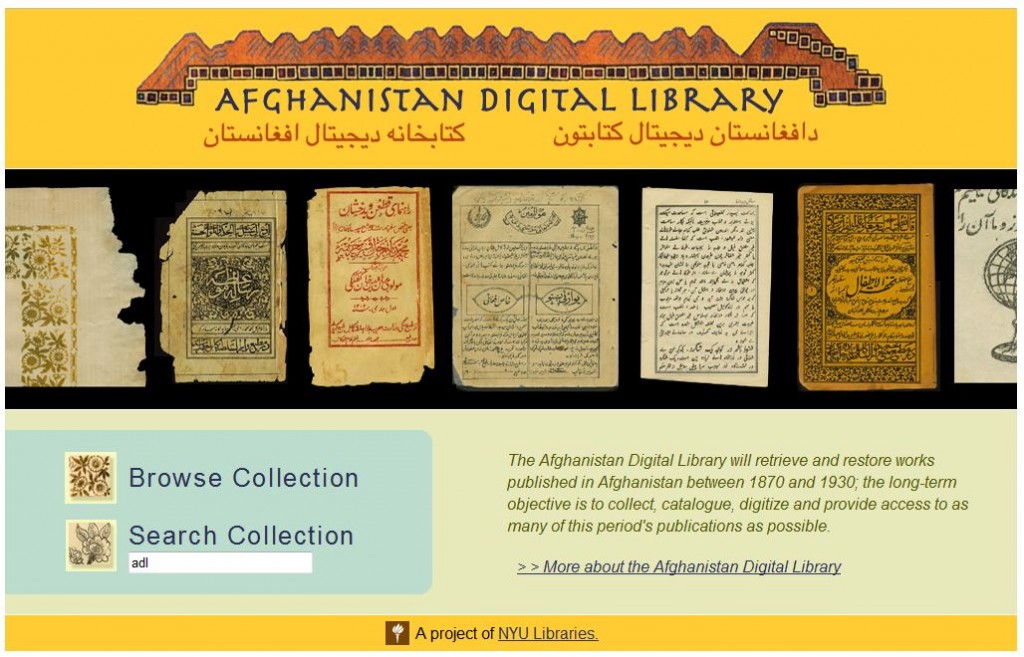Following a growing trend of digital portal libraries, the Digital Public Library of America (DPLA) website launched in April 2013. The Berkman Center for Internet & Society at Harvard University leads this ambitious project, which was sparked by an October 2012 meeting of forty leaders from libraries, foundations, academia, and technology projects. Starting from 2011, the Berkman Center took a two-year period to bring together hundreds of public and research librarians, innovators, digital humanists, and other volunteers helped to scope, design, and construct the DPLA. The project aims to collaborate online resources to create “an open, distributed network of comprehensive online resources that would draw on the nation’s living heritage from libraries, universities, archives, and museums in order to educate, inform, and empower everyone in current and future generations.”[2]
The freshly initiated DPLA project has a larger than 2 million collection contributed by 18 American archives, libraries, museums, and cultural heritage institutions to provide free access to students, teachers, scholars, and the public. They are hoping to get more partners as the project grows along.
DPLA is also features an innovative search portal. The portal provides special features like a map, a timeline, and several apps to improve discovery and creation. The map function shows the locations of items from a search request if the metadata records provide the location information. The timeline allows users to visually browse search results by year or decade. And the apps provide access to applications and tools created by external developers using DPLA’s open data. Thus, users of the Digital Public Library of America can create their own apps to browse the collection. These new features make DPLA more intuitive and visual.
In addition to its innovative display of search results, DPLA also creates a nationwide hub program: DPLA Digital Hubs Program. This network is supported by its more than forty state and regional digital libraries with their collections and services. These partners share their 250,000 metadata records resolving to digital objects, including online texts, photographs, manuscript materials, art work, etc. They also maintain and edit these records to keep them up to date. Furthermore, these state or regional digital libraries also offer their state or regional partners standardized digital services, ranging from digitization, metadata creation data aggregation and and storage. They also promote the digital collections locally to bring in more local users.
Specific hub lists can be found here: http://dp.la/info/about/who/partners/hubs/.
The University of Illinois Library is part of this new initiative. We have contributed more than 16,000 items and metadata for 15 of our digital collections to the DPLA, including the Motley Collection of Theatre and Costume Design, Portraits of Actors, 1720-1920, Historical Maps Online, and the Sousa Archives Music Instrument Digital Image Library. We are also one of the content hubs. We hope to contribute more in the future. DPLA gives both our library and the users more accessibility to share our collection. If you want more information of this project, please check their website at http://dp.la/.
Update: On June 18, 2013, the HathiTrust partnered with the DPLA “to expand discovery and use of HathiTrust’s public domain and other openly available content.”[5]
Other Digital Library Portals:
Europeana: http://europeana.eu/
World Digital Library: http://www.wdl.org/en/
The European Library (which Christina John posted about in January 2013): http://www.theeuropeanlibrary.org/tel4/
References:
[1] Digital Public Library of America. http://dp.la/.
[2] Digital Public Library of American. History. http://dp.la/info/about/history/
[3] Digital Public Library of America (DPLA) Launches Today. Berkman Center for Internet and Society. http://cyber.law.harvard.edu/node/8282.
[4] Digital Public Library of America. Wiki. http://en.wikipedia.org/wiki/Digital_Public_Library_of_America.
[5] HathiTrust to partner with DPLA. DPLA Blog. http://dp.la/info/2013/06/18/hathitrust-to-partner-with-dpla/




